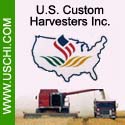 |
 |

|
|
|
Nebraska Ag News Headlines |
 |
Comparing Carbon Credit Programs Focus of New Report
Nebraska Ag Connection - 07/26/2021
With multiple carbon credit options and incentives now available, an economist with Iowa State University Extension and Outreach has compiled a comparison of programs and what is being offered to farmers.
Alejandro Plastina, associate professor in economics and extension economist at Iowa State, compared 11 private voluntary programs, across 26 characteristics, in a new report called "How to Grow and Sell Carbon Credits in US Agriculture" at www.extension.iastate.edu/agdm/crops/pdf/a1-76.pdf.
The report is featured in the July Ag Decision Maker at www.extension.iastate.edu/agdm/info/currentissues.html
and was co-written with Oranuch Wongpiyabovorn, graduate research student at Iowa State.
The programs compared include two carbon and ecosystem services credit entities (Ecosystem Services Market Consortium-ESMC and Soil and Water Outcomes Fund), two carbon credit entities (Indigo and Nori), four input suppliers (Agoro Carbon Alliance, Bayer, Corteva and Nutrien), and three data platforms (CIBO Impact, Gradable and TruCarbon).
Comparisons are made on such things as payments per new carbon credit, cost of participation, eligible crops, credit verification and much more.
"We thought that creating these comparisons would serve as a baseline for farmers, policymakers, extension personnel and others, to help understand what is known and unknown at this point," said Plastina.
As it turns out, Plastina said much is still unknown, or at least it is not yet known publicly.
"What we are seeing so far is more a patchwork than a market," he said. "There are different rules, incentives and penalties depending on the program. "The market is still in its formative stage and is very dynamic, focused on testing protocols through small-scale pilot programs, and lacks transparency and liquidity."
According to the report, programs are offering $15-$20 per carbon credit for pilot program participation, and each company calculates credits differently based on a different set of conservation or carbon sequestering requirements.
While most programs pay per carbon credit, some pay per farming practice, and others, such as the Soil and Water Outcomes Fund, pays per acre for selected farms in selected counties, that are making improvements related to carbon, water quality, etc.
Plastina said it's important to pay close attention to the contracts, especially the length of agreement and practices required. Many are 10-year contracts, outside of the pilot program, which is usually for one or two years.
While all programs require farmers to do something "different" to reduce carbon and receive ecosystem services payments, programs vary according to what exactly they consider "different." In some cases, it's a change with respect to what the farmer has done in the past, or a change based on what has been done in a specific geographic area.
He said farmers should also be mindful of future market changes. Although a price might be guaranteed upfront for pilot participation, that price will likely not hold for the duration of the long-term contract.
"Once those pilot programs go away it will be up to supply and demand to determine the price," he said.
Plastina said he plans to update the comparison as more information is made available. So far, most information is based on what can be found through internet searches.
A webinar about carbon markets and where they currently stand will be offered Aug. 11. The agenda and access information is available in the July Ag Decision Maker.
For more information, Plastina can be reached at 515-294-6160 or plastina@iastate.edu.
|
 |


|
 |
|
Copyright © 2024 - Farms.com. All Rights Reserved. |
 |
|